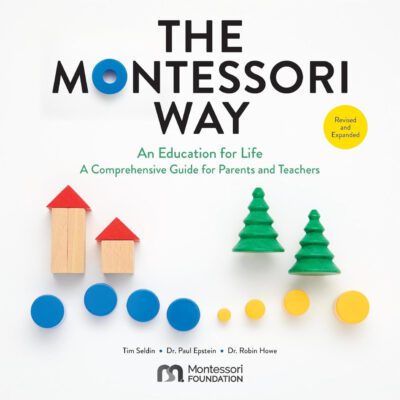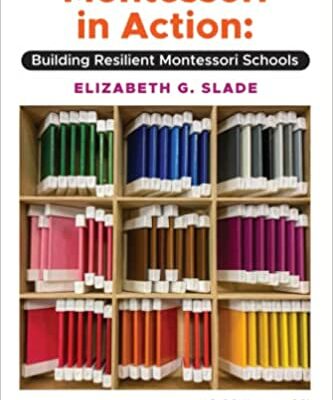by Robyn Zitnick
“The child should love everything that he learns, for his mental and emotional growths are linked. Whatever is presented to him must be made beautiful and clear, striking his imagination.
Since it has been seen to be necessary to give so much to the child, let us give him a vision of the whole universe. The universe is an imposing reality, and an answer to all questions.”
— Maria Montessori
Perhaps it happens on the first day of the elementary class or perhaps a few days later. A child, smiling broadly, arrives home to tell about the wonders of the day — the chart with the angels that carry the fire and the ice, the piece of terra cotta that is suddenly smashed, the paper that seems to defy gravity, and the volcano that really sparks and hisses and overflows with ash. And the story the teacher told!
That exciting and wonderful story about the coming of the universe and the earth! Montessori elementary has begun its new school year with the First Great Lesson, the story of the formation of the universe and the earth, and presented to the elementary child for his contemplation and study of the whole universe.
Dr. Montessori called upon a need to do “cosmic education.” To give the children the “whole” and the ability to see how the parts of the whole are interconnected was, in her view, the only approach that would truly satisfy the elementary child — the child who asks endless questions. Rather than force such a child to sit still and learn what has been chosen for him, she believed the child should be given everything to explore. The Great Lessons introduce everything that can be explored in one way or another. The Great Lessons inspire and activate the studies of the children and the work of the classroom.
The Five Great Lessons are not really lessons to be learned but are impressionistic stories to be told. “Impressionistic” means that these lessons are told as grand stories that will inspire and ignite the imagination, interest, and curiosity in the child rather than as a listing of facts. They are presented with drama, mystery, rich language, and awe. Dr. Montessori said that the Montessori elementary teacher must be a “storyteller of the truth.” She told her teachers to sow as many seeds of interest into the fertile minds of the children as are possible — some will germinate now; others will be held to do so later. When the child enters the elementary, he brings with him a reasoning mind, a mind capable of imagining the vastness of space and the march of time — so now we open the door to all of that through these Great Lessons of the elementary.
As well as possessing a powerful imagination, the child at this time is physically and intellectually strong. His need to know is as large as the universe and so that is what we lay before him. From this, he may eagerly choose his studies.
Generally, the children are told when a Great Lesson will be presented. Even for the children who have seen them each year, it is exciting to know one is coming. Every year they are a little different. Perhaps the teacher has brought some new artifacts to examine along with the story. Perhaps she adds some interesting facts that were not mentioned before.
Perhaps there are additional experiments. Perhaps the child hears some information that was missed in previous years. The children recognize elements of the stories ideas and facts that come from their own interests and independent studies. And then, there is always much that is new and fascinating and worthy of exploration. The Lesson is given; the discussion is opened; the exploratory work begins.
The First Great Lesson is the Coming of the Universe and the Earth. From nothing came into being the elemental universe. From that came our sun and its children, the planets. This lesson has many impressionistic charts and experiments that introduce geology, chemistry and more. From this lesson came earth science studies and the inspiration to appreciate an ordered and harmonious universe.
The Second Great Lesson is the Coming of Life. As a long, undated timeline is rolled out, the teacher points out the coming of the microorganisms, plants and animals that appeared on earth — each with a life to live and a contribution to make to the earth. When all was ready, at the very end of the timeline, we see human beings appearing. From this lesson came life-science studies and the inspiration to appreciate the service that all things do for each other and the great diversity of life.
The Third Great Lesson is the Coming of Human Beings. When human beings came, they came with three special gifts: a mind that could think and imagine, a hand that could work, and a heart that could love. And so it is today, as human beings, we must think, imagine, work and love. From this lesson some history, culture, and philosophy studies and the inspiration to appreciate what makes us fully human and the universal need to make a life for oneself in every place in every time.
The Fourth Great Lesson is Communication in Signs. We tell the story of the development of a written alphabet and the awesome ability we have to commit our thoughts to paper — thoughts that might endure for all time — using only 26 little, but very powerful, symbols. From this lesson came all language studies and the inspiration to appreciate the magnificent power of being able to read, understand, and write to communicate.
The Fifth Great Lesson is the Story of Numbers
We tell the story of the development of our decimal system of numeration and the powerful language of science, music, and design — mathematics. With only ten symbols and the use of the right place, any number can be symbolized and easily manipulated — thus making it possible to calculate and express even what we cannot encompass in our minds. From this lesson come all math and geometry studies and the inspiration to appreciate the discovery of the secrets of the universe, invention, and our modern world.
More than mere stories, Dr. Montessori saw these stories as setting the stage for the children to feel gratitude and admiration. In the first three Lessons, gratitude to God. In the last two Lessons, gratitude to man — often the unknown man or woman whose labor and insight built the foundations of knowledge and craft that gave us what we enjoy today. The Great Lessons are the starting point from which all of the work of the classroom begins. They are referred to when new work is introduced. They are never a work unto themselves for the children but are a tool to aid the teacher to inspire the children’s work. The Great Lessons are the heart and soul of the elementary classroom.
This appeared in Tomorrow’s Child Magazine Spring 2001






